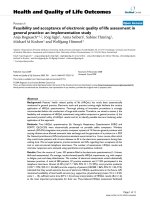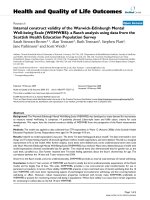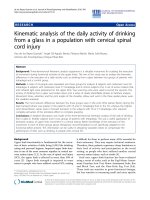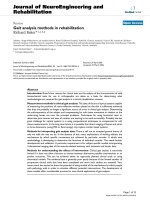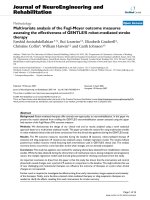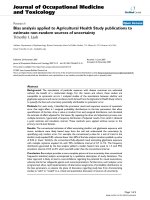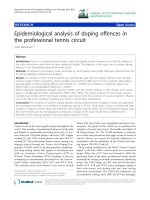Báo cáo hóa học: " Bioinformatic analysis suggests that the Cypovirus 1 major core protein cistron harbours an overlapping gene" pdf
Bạn đang xem bản rút gọn của tài liệu. Xem và tải ngay bản đầy đủ của tài liệu tại đây (217.6 KB, 4 trang )
BioMed Central
Page 1 of 4
(page number not for citation purposes)
Virology Journal
Open Access
Short report
Bioinformatic analysis suggests that the Cypovirus 1 major core
protein cistron harbours an overlapping gene
Andrew E Firth* and John F Atkins
Address: BioSciences Institute, University College Cork, Cork, Ireland
Email: Andrew E Firth* - ; John F Atkins -
* Corresponding author
Abstract
Members of the genus Cypovirus (family Reoviridae) are common pathogens of insects. These viruses
have linear dsRNA genomes divided into 10–11 segments, which have generally been assumed to
be monocistronic. Here, bioinformatic evidence is presented for a short overlapping coding
sequence (CDS) in the cypovirus genome segment encoding the major core capsid protein VP1,
overlapping the 5'-terminal region of the VP1 ORF in the +1 reading frame. In Cypovirus type 1
(CPV-1), a 62-codon AUG-initiated open reading frame (hereafter ORFX) is present in all four
available segment 1 sequences. The pattern of base variations across the sequence alignment
indicates that ORFX is subject to functional constraints at the amino acid level (even when the
constraints due to coding in the overlapping VP1 reading frame are taken into account; MLOGD
software). In fact the translated ORFX shows greater amino acid conservation than the overlapping
region of VP1. The genomic location of ORFX is consistent with translation via leaky scanning. A
62–64 codon AUG-initiated ORF is present in a corresponding location and reading frame in other
available cypovirus sequences (2 CPV-14, 1 CPV-15) and an 87-codon ORFX homologue may also
be present in Aedes pseudoscutellaris reovirus. The ORFX amino acid sequences are hydrophilic and
basic, with between 12 and 16 Arg/Lys residues in each though, at 7.5–10.2 kDa, the putative ORFX
product is too small to appear on typical published protein gels.
Findings
The genus Cypovirus (cytoplasmic polyhedrosis viruses;
CPVs) is one of ≥ 12 genera within the Reoviridae, a family
of segmented dsRNA viruses. While other members of the
family infect mammals (e.g. Bluetongue virus), including
humans (e.g. rotaviruses, coltiviruses, mammalian
orthoreoviruses and seadornaviruses), CPVs infect insects.
CPV species have been divided into 16 or more types
(CPV-1, CPV-2, etc) based on electrophoretic migration of
the genome segments [1]. Of the 352 Reoviridae RefSeqs in
GenBank (10 Apr 2008; 33 species × 9–12 segments per
species), only ~5% are multicistronic. Among these are a
few examples of fully overlapping genes apparently trans-
lated via leaky scanning, for example in mammalian
Orthoreovirus segment S1 [2], Phytoreovirus segment S12 or
S9 [3], and (currently not experimentally verified) Orbivi-
rus segment 9 [4]. Such overlapping CDSs can be difficult
to detect using conventional gene-finding software [5],
especially when short. The software package MLOGD,
however, was designed specifically for identifying such
CDSs, and includes explicit models for sequence evolu-
tion in double-coding regions as well as models for single-
coding and non-coding regions [5,6]. Using MLOGD, we
recently identified – and subsequently experimentally ver-
Published: 20 May 2008
Virology Journal 2008, 5:62 doi:10.1186/1743-422X-5-62
Received: 16 April 2008
Accepted: 20 May 2008
This article is available from: />© 2008 Firth and Atkins; licensee BioMed Central Ltd.
This is an Open Access article distributed under the terms of the Creative Commons Attribution License ( />),
which permits unrestricted use, distribution, and reproduction in any medium, provided the original work is properly cited.
Virology Journal 2008, 5:62 />Page 2 of 4
(page number not for citation purposes)
ified – a new short CDS in the Potyviridae family that over-
laps the P3 cistron but is translated in the +2 reading
frame [7]. When we applied MLOGD to the cypoviruses
we also found evidence for a short overlapping CDS. Here
we describe the bioinformatic analysis.
The putative new CDS (hereafter ORFX) was first identi-
fied in an alignment of the RefSeq [GenBank:
NC_003016
] with its CPV-1 genome neighbours. Subse-
quently, all homologous CPV sequences in GenBank were
located by applying tblastn [8] to the NC_003016
VP1
amino acid sequence, resulting in the sequences [Gen-
Bank: AF389462
] – Lymantria dispar cypovirus 1 segment 1
(CPV-1), [GenBank: AF323781
] – Bombyx mori cypovirus 1
segment 1 (CPV-1), [GenBank: AY163247
] – Dendrolimus
punctatus cypovirus 1 segment 1 (CPV-1), [GenBank:
AY388398
] – Bombyx mori cypovirus 1 segment 1 (CPV-1),
[GenBank: AF389453
] – Lymantria dispar cypovirus 14 seg-
ment 2 (CPV-14), [GenBank: DQ388474
] – Heliothis
armigera cypovirus 14 segment 2 (CPV-14), [GenBank:
AF291684
] – Trichoplusia ni cypovirus 15 segment 2 (CPV-
15), and [GenBank: DQ087278
] – Aedes pseudoscutellaris
reovirus segment 3 (APRV). APRV has only 9 segments and
is not classified as a cypovirus [9], but was nonetheless
included in the analysis. Note that the GenBank RefSeqs
NC_003016
, NC_003007 and NC_002558 were derived,
respectively, from AF389462
, AF389453 and AF291684.
In the four CPV-1 sequences, ORFX has 62 codons (nt
coords AF389462:77 262; 7.5 kDa) and overlaps the 5'-
terminal region of the VP1 ORF (nt coords
AF389462:40 4038) in the +1 reading frame (Figure 1).
Here the VP1 ORF starts at AUG2 (context acgAUGc)
while ORFX starts at AUG3 (context auaAUGa).
Interestingly, AUG1 (context [g/u]guAUGu; nt coords
AF389462:11 13) is also in the ORFX frame and, in
AY163247 and AF323781, could allow a 22-aa N-termi-
nal extension of ORFX; however, in AF389462, there is an
in-frame termination codon four codons 3' of AUG1 and,
furthermore, the MLOGD results (Figure 1; see below) do
not support the N-terminal extension.
In order to measure the coding potential of ORFX in CPV-
1, we used MLOGD [5]. Applied to an alignment of the
four CPV-1 sequences, MLOGD detected a strong coding
signature for ORFX, with three non-overlapping – and
hence completely independent – positively scoring win-
dows in the ORFX region (Figure 1). The number of inde-
pendent base variations across the alignment within the
ORFX region is N
var
~ 33, and the total MLOGD score is
log(LR) ~ 23.4 (see [6] for details). Extensive tests with
known single-coding and double-coding virus sequence
alignments indicate that 'N
var
≥ 20' and 'log(LR) ≥ ×
N
var
' signals robust detection (<1% false positive rate) of
an overlapping same-strand CDS [6] (and unpublished
data). Moreover, the MLOGD results showed that the
ORFX amino acid sequence is considerably more con-
served at the amino acid level than the overlapping region
of VP1 (Figure 1). Indeed, in pairwise comparisons
between AF389462 and each of the other three CPV-1
sequences, there was 92–100% amino acid identity in
ORFX, but only 74–77% amino acid identity in the over-
lapping region of VP1.
In the two CPV-14 sequences, ORFX has 64 codons (nt
coords DQ388474:70 261; 7.7 kDa) and overlaps the 5'-
terminal region of the VP1 ORF (nt coords
DQ388474:39 3947) in the +1 reading frame. In
DQ388474, the VP1 ORF starts at AUG2 (context
gauAUGu) while ORFX starts at adjacent AUG [34] (con-
texts aagAUGAUGa). AUG1 (context uagAUGa) at nt
coords DQ388474:20 22 is in the -1 frame relative to the
VP1 ORF and heads a 15-codon ORF terminating at a UAA
codon which is separated from the ORFX AUG codon by
a 2-nt spacer. In AF389453, the annotated VP1 ORF starts
at nt 261 (the first VP1-frame AUG codon), however, by
homology with DQ388474, VP1 initiation likely (also)
occurs at a GUG (context gauGUGu) codon aligning with
the VP1 AUG codon in DQ388474. AUG2 itself overlaps
the GUG codon in the +1 frame relative to the VP1 ORF
and heads a 6-codon ORF terminating at a UAA codon
which is separated from the ORFX AUG codons (adjacent
AUG [34]) by a 12-nt spacer. As in DQ388474, AUG1
heads a 15-codon ORF that overlaps the VP1 ORF GUG
codon and terminates just 5' of AUG3.
In AF291684 (CPV-15), ORFX has 62 codons (221 406;
7.8 kDa), and overlaps the VP1 ORF (34 4119) in the +1
reading frame. The VP1 ORF starts at AUG1 (context
aguAUGu) but ORFX starts at AUG5 (context auaAUGc),
with AUG [234] in the ORFX frame but heading two short
ORFs: AUGaacUGAucaAUGaaaAUGaguuacUAG (nt
coords 83 112).
In DQ087278 (APRV), ORFX has 87 codons (113 373;
10.2 kDa), and overlaps the VP1 ORF (34 3639) in the +1
reading frame. The VP1 ORF starts at AUG1 (context
uuuAUGa) and ORFX starts at AUG3 (context aaaAUGa),
with AUG2 (context agaAUGu) being in the VP1 frame,
five codons 3' of AUG1.
MLOGD can not be used effectively on an alignment of all
eight sequences because the pairwise divergences are too
great, so we can not robustly assess the coding potential of
ORFX outside of CPV-1 with the currently available
1
6
Virology Journal 2008, 5:62 />Page 3 of 4
(page number not for citation purposes)
sequence data. However, the fact that the +1 frame ORF is
present at the same alignment location in all eight
sequences, even though the mean divergence of the 8-
sequence alignment within the ORFX region is ~1.5 inde-
pendent base variations per alignment nucleotide col-
umn, suggests that it is functionally important.
The genomic location of ORFX is more-or-less consistent
with a leaky scanning model for ORFX translation, albeit
perhaps at relatively low efficiency since the contexts of
the VP1 initiation codons are not particularly weak. The
frequent presence of an additional AUG codon, preceding
both the ORFX and VP1 AUG codons, is a little confusing
both for VP1 and ORFX translation though, in some cases,
MLOGD statistics for the alignment of four CPV-1 segment 1 sequencesFigure 1
MLOGD statistics for the alignment of four CPV-1 segment 1 sequences. The four sequences were aligned with
code2aln [15]; the alignment is gapless within the VP1 ORF. (1)–(3) The positions of stop codons in each of the four
sequences in each of the three forward reading frames (frame defined by alignment to the reference sequence [GenBank:
AF389462
]). Note the conserved absence of stop codons in the +0 frame within the VP1 ORF and in the +1 frame in the
ORFX region. (4)–(7) MLOGD sliding-window plots. Window size = 20 codons. Step size = 10 codons. Each window is rep-
resented by a small circle (showing the likelihood ratio score for that window), and grey bars showing the width (ends) of the
window. See [6] for further details of the MLOGD software. In (4)–(5) the null model, in each window, is that the sequence is
non-coding, while the alternative model is that the sequence is coding in the window frame. Positive scores favour the alterna-
tive model. There is a strong coding signature in the +0 frame (4) throughout the VP1 ORF, except where it overlaps ORFX.
In this region there is a strong coding signature in the +1 frame (5) indicating that ORFX is subject to stronger functional con-
straints than the overlapping section of VP1. In (6)–(7) the null model, in each window, is that only the VP1 frame is coding,
while the alternative model is that both the VP1 frame and the window frame are coding. Only the +1 (6) and +2 (7) frames are
shown because the +0 frame is the VP1 frame which is included in the null model. Scores are generally negative with occasional
random scatter into low positive scores, except for the ORFX region which has consecutive high-positively scoring windows
(6). (8) Map of the reference sequence [GenBank: AF389462
].
positions of
stop codons
(triangles)
(1)
Frame = +0
(2)
Frame = +1
(3)
Frame = +2
MLOGD log likelihood ratio per 20 codon window
positive values
=> coding
negative values
=> non−coding
−20
−10
0
10
(4)
Frame = +0
null model =
non−coding
−20
−10
0
10
(5)
Frame = +1
null model =
non−coding
−20
−10
0
10
(6)
Frame = +1
null model =
VP1
−20
−10
0
10
(7)
Frame = +2
null model =
VP1
0 1000 2000 3000 4000
VP1 / major core protein
ORFX
(8)
alignment coordinate (nt)
Virology Journal 2008, 5:62 />Page 4 of 4
(page number not for citation purposes)
this AUG codon may play a role in moving some ribos-
omes past the VP1 initiation codon, allowing them to
reinitiate at the ORFX AUG codon. There may also be
other cis-elements that promote ORFX translation
(although we were unable to locate candidate RNA sec-
ondary structures for this purpose). The presence of two
short intervening ORFs argues against simple leaky scan-
ning in CPV-15. It is interesting, and possibly relevant,
that in another Reoviridae species – Avian reovirus – a
novel, as yet not fully understood, scanning-independent
ribosome migration mechanism is used to bypass two
upstream CDSs in order to translate the 3'-proximal CDS
on the tricistronic S1 mRNA [10].
In AF389462 (CPV-1), the ORFX peptide sequence is
MKRNINNQKLTAVQIMEKERQEHAIKQLEILRLKRELEM-
KRKQVQALEDRLMARAVVEQMQK. With the exception
of APRV, the 62–64-aa ORFX peptide sequence is very
hydrophilic (≥ 60% of residues are polar) and basic (22–
27% of residues are basic) with 13–16 Arg/Lys residues.
The APRV ORFX peptide sequence is longer (87 aa) but
has a similar hydrophobicity profile, is also basic, and
contains 12 Arg/Lys residues. One potential function for
ORFX product may be suppression of silencing via dsRNA
binding (cf. [11]). Alternatively, the Arg/Lys residues may
mediate nuclear localization. Application of blastp [8] to
the eight ORFX peptide sequences revealed no similar
amino acid sequences in GenBank (10 Apr 2008). Simi-
larly, application of InterProScan [12] returned no hits
(protein motifs, domains etc).
The VP1 protein itself (~150 kDa) has been identified as
the major capsid protein [13,14]. It shares some homol-
ogy with the Oryzavirus major capsid protein P3 [13] and,
expressed independently, assembles into single-shelled
virus-like particles [14]. Our analysis indicates that the 5'-
terminal region of the VP1 ORF encodes, in the +1 read-
ing-frame, an additional 7.5–7.8 kDa protein. Cypovi-
ruses have potential uses in insect pest control and are
also important pathogens of commercially important
insects such as silkworms. Although much remains to be
discovered about even the ten known cypovirus proteins,
it is important to know of any additional proteins as early
as possible. In particular, if an overlapping gene remains
undetected, then its functions may be wrongly attributed
to the gene that it overlaps, leading to persistent and
wasteful confusion. We hope that presentation of this bio-
informatic analysis will stimulate an attempt to experi-
mentally verify the expression and functional role of
ORFX product. Initial verification could be by means of
immunoblotting with ORFX-specific antibodies, bearing
in mind, however, that it may be expressed at relatively
low levels.
Competing interests
The authors declare that they have no competing interests.
Authors' contributions
AEF carried out the bioinformatic analysis and wrote the
manuscript. Both authors edited and approved the final
manuscript.
Acknowledgements
This work was supported by an award from Science Foundation Ireland to
John F Atkins.
References
1. Mertens PPC, Rao S, Zhou H: Cypovirus, Reoviridae. In Virus Tax-
onomy, VIIIth Report of the ICTV Edited by: Fauquet CM, Mayo MA,
Maniloff J, Desselberger U, Ball LA. London: Elsevier/Academic Press;
2004:522-533.
2. Ernst H, Shatkin AJ: Reovirus hemagglutinin mRNA codes for
two polypeptides in overlapping reading frames. Proc Natl
Acad Sci USA 1985, 82:48-52.
3. Suzuki N, Sugawara M, Nuss DL, Matsuura Y: Polycistronic (tri- or
bicistronic) phytoreoviral segments translatable in both
plant and insect cells. J Virol 1996, 70:8155-8159.
4. Firth AE: Bioinformatic analysis suggests that the Orbivirus
VP6 cistron encodes an overlapping gene. Virol J 2008, 5:48.
5. Firth AE, Brown CM: Detecting overlapping coding sequences
with pairwise alignments. Bioinformatics 2005, 21:282-292.
6. Firth AE, Brown CM: Detecting overlapping coding sequences
in virus genomes. BMC Bioinformatics 2006, 7:75.
7. Chung BYW, Miller WA, Atkins JF, Firth AE: An overlapping
essential gene in the Potyviridae. Proc Natl Acad Sci USA 2008,
105:5897-5902.
8. Altschul SF, Gish W, Miller W, Myers EW, Lipman DJ: Basic local
alignment search tool. J Mol Biol 1990, 215:403-410.
9. Attoui H, Mohd Jaafar F, Belhouchet M, Biagini P, Cantaloube JF, de
Micco P, de Lamballerie X: Expansion of family Reoviridae to
include nine-segmented dsRNA viruses: isolation and char-
acterization of a new virus designated Aedes pseudoscutella-
ris reovirus assigned to a proposed genus (Dinovernavirus).
Virology 2005, 343:212-223.
10. Racine T, Barry C, Roy K, Dawe SJ, Shmulevitz M, Duncan R: Leaky
scanning and scanning-independent ribosome migration on
the tricistronic S1 mRNA of avian reovirus. J Biol Chem 2007,
282:25613-25622.
11. González-López C, Martínez-Costas J, Esteban M, Benavente J: Evi-
dence that avian reovirus
σ
A protein is an inhibitor of the
double-stranded RNA-dependent protein kinase. J Gen Virol
2003, 84:1629-1639.
12. Zdobnov EM, Apweiler R: InterProScan – an integration plat-
form for the signature-recognition methods in InterPro. Bio-
informatics 2001, 17:847-848.
13. Hagiwara K, Rao S, Scott SW, Carner GR: Nucleotide sequences
of segments 1, 3 and 4 of the genome of Bombyx mori cypo-
virus 1 encoding putative capsid proteins VP1, VP3 and VP4,
respectively. J Gen Virol 2002, 83:1477-1482.
14. Hagiwara K, Naitow H: Assembly into single-shelled virus-like
particles by major capsid protein VP1 encoded by genome
segment S1 of Bombyx mori cypovirus 1. J Gen Virol 2003,
84:2439-2441.
15. Stocsits RR: Nucleic Acid Sequence Alignments of Partly Cod-
ing Regions. In PhD thesis University of Vienna; 2003.

